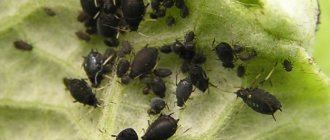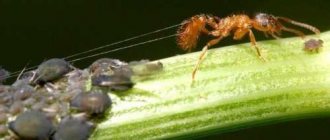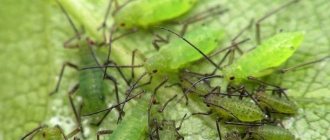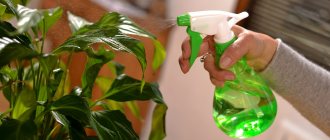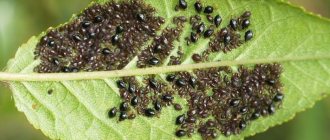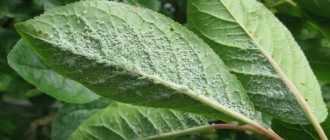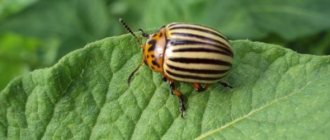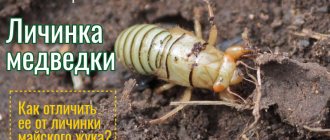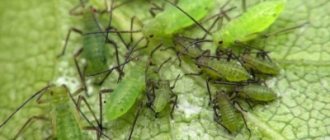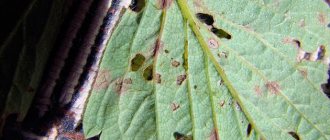Entomophages are insects that gobble up other insects “on both cheeks.” Recently, there has been a tendency to distribute the most useful of them around the world. Opponents of GMOs, pesticides and other chemicals in the fields actively advocate for this.
Yellow ladybug with white spots and aphid
Read on dacha6.ru:
Ladybugs in the country
How to deal with aphids in June
Such insects “shoulder to shoulder” in a single cohesive formation, together with ordinary summer residents, stand to protect the garden from all kinds of pests. Today we will talk about using this approach in the fight against aphids.
In addition to ladybugs in the adult stage and their equally voracious larvae, aphids have many other natural enemies. Insects include: predatory bugs, Atheta coriaria beetles, Aphidius wasps and other ichneumon wasps, ground beetles, earwigs, lacewing larvae, hoverfly larvae, fire beetle larvae.
By the way, people can also be entomophages. In any case, in the countries of Southeast Asia, Central and South America, dishes with insect larvae and other beetles are not considered something out of the ordinary. It’s not worth mentioning that in France they serve dishes with grape snails for big money.
Considering the prices for beets, carrots and chicken this season, natural food rich in environmentally friendly proteins may well complement the usual diet of both a summer resident and an amateur gardener.
Wasp Aphidius Colemani
I don’t know how many summer residents have watched the film “Alien,” but in this situation the analogy would be quite appropriate.
Aphids, thrips, whiteflies - all of them are suitable to become living incubators for the larvae of the overly prolific and formidable entomophage - the wasp Aphidius Colemani.
Aphidius, by piercing the outer shell, lays a small egg into the body of the victim, from which an incredibly voracious carnivorous larva soon emerges. Without wasting a single free second, it begins to devour the body of its owner from the inside, and then uses the lifeless outer shell as a cocoon for pupation, from which an adult emerges after some time.
Signs of plant damage
Aphids on plants.
External signs of aphid infestation include:
- the presence of larvae or adults on the leaves;
- painful condition of the leaves. They turn yellow, elasticity is lost, and death occurs;
- weak inflorescences with no ovaries;
- viscous and sticky surface.
The underside of leaves and flowers are favorite habitats . The appearance of the larva occurs up to 14 days. The life cycle lasts up to 30 days. The larva actively feeds on sap, which contains a lot of nutrients.
You can get acquainted with aphids in the article at the link.
Earwigs
Many summer residents do not like and are even afraid of earwigs and try to drive them away from the site as quickly as possible. Meanwhile, these insects, armed with powerful mites, actively eat aphids, woodlice and other garden pests.
The larvae hatched from the clutch are so insatiable that they often devour their own mother, who carefully guarded them throughout the long winter.
If you are not afraid of accidental earwig bites, try to create favorable conditions for them in your dacha, in particular, by installing flower pots with wood shavings, laying out plywood and planks in damp nooks.
Insect predators
In nature, there are natural enemies of aphids, predatory insects and birds, for which they represent a diet. They can help a person fight such insects.
The main lover of tasty aphids is the ladybug and its larvae. Therefore, they are assistants in the garden to destroy pests. According to scientists, one beetle can eat 50 aphids or their eggs per day.
Predatory insects that eat aphids Especially quickly destroy small parasites of the larvae of ladybirds, which in appearance are not at all similar to adult individuals. They are gray-black in color and flatter in shape, have red-yellow spots on the sides, and are larger than their parents. Since they are still growing, they need to eat well. Each young individual that feeds on aphids is capable of absorbing 70-100 units per day, which brings great benefits to the garden.
Interesting!
Observations by biologists show that when ladybugs attack, the entire colony of pests panics, active movement begins, and many winged individuals appear, which in this way escape from the attack of a predator.
In addition to colorful beetles, aphids form the basis of the diet for lacewings and sand wasps, which can eat 100-150 individuals per day.
Among insects, aphids are also eaten by those species for which they are food only when encountered: earwigs, cicadas, crickets, hoverflies, ground beetles and several species of spiders.
Important!
These types of insects are of great benefit to the garden, so before using insecticides, gardeners should think about the fact that they will kill not only pests, but also those who benefit.
Birds that eat aphids
Ants are reliable bodyguards, but only in those cases when we are talking about opponents of comparable strength from the world of insects. If birds get involved, these well-coordinated workers, without saying a word, abandon their “pastures” and hurry to get away.
Among those who like to snack on aphids are sparrows, tits, linnets, wrens, warblers (willow warblers and chiffchaffs), kinglets and some others.
When robins hear a voice, the aphids should immediately begin to move their “rolls” more actively.
© Ilya Vladimirovich | 2021-06-19 That same gardener
Prevention
In order to avoid having to frantically search for many methods to combat aphids in spring and summer, it is necessary to carry out health procedures in the fall. An initially well-kept garden will only work to your advantage.
In order to reduce the number of aphids settling on your site, you need to carefully monitor the condition of the trees. Seasonal whitewashing is also a must. Remove leaves and dead wood that has accumulated on the ground. Reduce the number of anthills. Plant care is the main method of pest control .
Appearance Features
Lacewings have a green or light brown body color. The wings are thin, mesh, shiny.
The body length of the lacewing reaches 10 millimeters, and the wingspan is 30 millimeters. The eyes are golden-shiny.
Lacewing larvae have well-developed thoracic legs. There are claws on the paws. On the abdominal and thoracic segments there are paired humps studded with shields and hooked ends. It has large sickle-shaped jaws on its head.
Lacewing (Chrysopidae).
Lacewing eggs are oval shaped. Their color is yellowish or light green.
Other methods
Despite new and proven methods for killing aphids, many people prefer traditional methods. Among the most effective are several methods:
- Spraying with water .
A stream of liquid can knock insects to the ground, from where they can no longer return to the plant. This method is suitable exclusively for early spring, when aphids are just emerging and do not yet have wings for movement, and large concentrations of ants are undesirable on your site, since they are the ones who carry aphids (you can find out more about the symbiosis of ants and aphids here). - Soap solution . The sharp smells of soap will help repel pests; it is best to use household soap and tar soap. Preparation: 100 gr. dissolve soap in 10 liters.
- Ash infusion. This method is effective in two directions at once: ash is an excellent fertilizer for the garden and at the same time fights pests.
- It is necessary to dilute 0.5 kg of ash in 5 liters of hot water and let it brew for several days under the lid.
- Then boil and cool.
- Afterwards you can spray the plants.
In order to no longer be bothered by the problem of aphids in the garden and you can regularly get a good harvest and moral satisfaction from work, pay great attention to caring for plants, follow the basic rules for their prevention, pay attention to high-quality soil fertilization and be sure to attract useful ones to the site. insects _
All of the above methods will help you effectively prevent or destroy the development of aphids.
You can find out more about the most effective folk remedies for aphids here.
Video Who is grazed and milked by ants educational cartoon for children
All summer, ants tirelessly transfer their precious nurses from one plant to another, and in the fall they bring them into their warm anthills so that the aphids do not freeze in winter. The ants even look after their eggs all winter, licking them and storing them.
In the spring, before the leaves bloom, caring owners take the nurses out into the sun for an hour or two so that they can get some fresh air. The aphids will soak up nature and then go home again to the anthill. And so on until the grass and trees turn green! Then the command “90 days for looting!” comes. - and history repeats itself...
Over centuries of symbiosis, Aphids and Ants have become so closely related that when families of ants move to new places, many take aphids with them.
This is the story that is happening in our dacha world))) What Nature can’t come up with! And although all this is just an example of myrmecophily (mutually beneficial relationships between aphids and ants), but how all this resembles an educational cartoon for children...,
This is what is happening in all our summer cottages, under the leaves and on the roots... And now it has become a little more clear what needs to be done so that the tender leaves of currants, raspberries and plums do not turn into pastures for millions of little pumps with proboscis...
Consumption of cockroaches by humans
Humans are also on the list of animals that feed on cockroaches. In Asian and African countries, insect dishes are offered in expensive restaurants. They are specially bred in insectariums. These and similar creatures are considered healthy dietary foods. Small cockroaches are eaten at home, fried in a frying pan. In restaurants and cafes, cockroaches are served in various sauces, both raw and cooked.
The list of those who eat cockroaches is quite small. Prussians are not the main food for anyone. These insects are fed to the inhabitants of terrariums twice a week. Birds, monkeys and rodents eat far fewer pests.
Source: https://svekrovi.net/pests-and-insects/cockroaches/kto-est-tarakanov.html
What is he afraid of?
The smell of some plants is not acceptable to aphids - these are onions, garlic and Dalmatian chamomile. If you plant or place Dalmatian chamomile in pots next to the seedlings, the aphids will disappear.
But there are plants, on the contrary, that are very attractive to aphids, a kind of “distraction”.
These are nasturtium, cosmos, poppy, mallow, tuberous begonias, as well as viburnum and linden. By alternating their planting, you can reduce the likelihood of aphids attacking garden and vegetable crops.
Plant species that attract aphids should not be planted next to protected ones. Although sometimes nasturtiums are planted around fruit trees so that aphids immediately settle on them. In the future, herbaceous plants along with aphid colonies can be easily mowed down and destroyed.
There are also various methods and methods for getting rid of aphids: agrotechnical, biological, mechanical and chemical.
You can learn more about them in the article “Methods and methods of controlling aphids.”
� ��� �������� ����� �������?
������
— . - . . 3 -. , , 28- (Henosepilachna vigintioctomaculata Motsch.), Epilachna. (Subcoccinella viginti quatuorpunctata L.) . , , (Cynegetis impunctata L.).
? . , , , , , . — (Coccinella septempunctata L.) - .
Gerda
���
���� � ��������
����
��� � ������ ��������. �������� ��������! :)))
������*
����
������� �������
����
���� ��������
����….
Ilya Burov
���� ������ ������� ���������������� ��� ����������, ����� ��� ����� ��������. ������ �������� � 11, ���� 10 ���������� �������, ���������������� �� ����� ��������� ���� ������ � �������� ����������� ��� ������. ������ ������� �� 5 ��������� ��������.
[�������] ����� �����
, ; , , . , , , . , , . , . . ; , . , ; 3-, 3-4 ; . . , , , (. Epilachna), , .
[�������] �������������
1000 , . : , , ; ? , ; ; , ; , , . ( nella septempunctata). 7-8 . ; 7 , , . .
����
��� �����������, ��� � ������� ��� �����������-���������, �� � ��������!!!
�����
��� ������. � ��� ����� � ���.
������ �������
���� ���!
aq
����� ���������� �, ��������� � ������� ����������� ����� ������� ���������� ��� ���, �����������, �������, ������� � �����, �������� ��������� ������ ��������� ���������
����� �������
����, ��� �� ����� ���?
�������� �� ��, ��� ���������� ��������� ���� ������������ ���, ������ �������� ������ �������� ������ ����� � ������� ���. ��� ��������� ���������� ��������� 1 �� � 5 �� � �����, ��������� ������� ����� ������ ��������� � ��������. ��� ���������, �������������������� �������� �������� � ������� ���� ��������, ������� ��� �������� ����� ������������ ����� �� ������, ������ � ����� ��� ���. �������� ���, ��� ����� ������� ��������� �������, ������� ����� ������ � ����� �������� ���� ��������.
��� ����������� �����, ��� ����� ����� ������� ���������, � ��� ��� ��� ������������ ����� �����, ��� � ��� ������� � ������� ���������� �����, �� �������� ����������. ������� — ����� ���������������� �����, ��� ��� ������� � ������ �������� ������ ���� ��������, � ����� ������ ������������ ������� ������ � �������� ���������.
����, ��� �� ����� ���������� �� ���?
� �������, ���������� ����� �������� ���������� �� ���� ���������, ��� ��� �������� �� ��������� �� ���� ��������.
������� ����
������� ���� ����� ���������� ������ �� ���������� �� ���: �������� ���� ��� ������ ������������� �������� � ����� � ���������� ���� ��������. ���� ���� ������ ��������� �� ���������, �� ������� ����� ������ ������� �� ���������.
����� �������
����� ������� ����� �������� ����; �������� ����� ������� �������� ������� ����� �� ����������� ���. ��� �� ������� ������, �� ���� �� ����� �����������. ������ ���� �������, ��� ���� ���������� ������������� � ����� �������, �� ��� ��������� ������ �������. ���� ������ �������� ����� ���������� � ����� ����� ������ ������ ������� � ����������� ��������� ��� �������� � ���, ��� ������� ��� ������ ��������.
����������
���������� �������� ������ �������� ��� ���. �� ����� ��������, ��� ����� �������. ����������� ��������� ������ �������� �������� ��� �������� ������������� ����, �������� ����������� �������� �� ����������� ���������� � ��� ������; ��� ����� ���� �������� ( �������� � ������� � ���������� ����������) , ��������� ��������, ����������, �������, ������� � ��������.
�������� ��������
�������� ��� ���������� ��������, ������� ������ ���������� ������� � �������� ���������� ���, ��� ��� ��� ���������� ����������� �������� �� ��������� �� ������� � ������. ���������� ���� �� ���� �������� ����� ������ �����, ��� ���������� ��������� ���.
�������� �� ���������
�� ����� ������, ����������� �������� ������ ������� ��� ����������� ��� ��� ������ ��������� ��� �� ����� �����, ��� � �� ��� ������, �� ���� ��� ���������� ����������, �� ���������� ���� ����� ����� ������������� � ����. ���������� ����� ����� ������� �� ����������� ���, � �� ����� ����������, ������� �������� ����������� � �������� ��������� �����������. ����� ���������� ����������� �����������, ������� ���������, �� �� �������� �� ��� ���������� �, ��������, ����� �� ��������� ��������� ���, ����������� ��������� ����������� ��� �����.
�������
������… �� ����� ���� ������� �� ��� �������…. � ����� ����������� ��� ���� ���������… ����� ������� ��� ������� ������ ����� ����� ���� ��������..))
*** [email protected] @n ***
, ; , , . , , , . , , . , . . ; , . , ; 3-, 3-4 ; . . , , , (. Epilachna), , .
Practical significance of bloodworms
Another name for mosquito larvae is bloodworm. Since not only toads, but also fish actively feed on these small worms, they are often used by aquarists, as well as experienced fishermen. Bloodworms go on sale after careful packaging. This is because small larvae are suitable only for aquarium phenotypes, but large ones are suitable for catching river fish. How actively a barb or gudgeon will consume mosquito offspring depends on the degree of its freshness and proper preparation. Therefore, experienced fishermen purchase larvae for feeding only in specialized departments.
Nutrition of aquarium fish
Many aquarium phenotypes feed on mosquitoes and flies. The following varieties are preferred for bloodworms:
- Trout.
- The Golden Cockerel.
- Whitefish.
- Roach.
- Cichlids.
- Gury.
The amount consumed by a particular phenotype depends on its size as well as taste preferences. Some river fish feed only on mosquitoes and their larvae. Anglers take advantage of this by using fresh bloodworms for feeding. Some phenotypes catch those mosquitoes that move above the water surface. Other species use a stream of water to dislodge the insect and obtain the required amount of food. Most often, the pests are knocked down by splashers.
The use of larval-eating fish in the fight against malaria
Among those that feed on the larvae of malaria mosquitoes are the mosquito fish. These fish are found in America. They live and develop both in the central part and in the south. Although their diet may include zooplankton that is of suitable size, mosquito fish prefer bloodworms. Therefore, these phenotypes settle in water bodies that are filled with the offspring of malaria mosquitoes.
Since mosquitoes cause significant harm to people around the world, mosquito fish are artificially bred in many bodies of water. Today they are found not only in the USA, but also in Russia. Gambusia were actively bred on the Black Sea coast in the 50s. At that time, a huge number of soldiers and ordinary citizens died from malaria in the Caucasus. It took about 10 years to completely cope with the disease, as well as destroy the huge population of malaria mosquitoes.
Now scientists are actively reducing the populations of mosquito fish. This is because fish can eat not only bloodworms. If there is a lack of food familiar to them, then gambusia eat fry and young fish that are unable to defend themselves.
What do dragonflies eat?
One of the most mobile large insects, dragonflies, are real hunters. Possessing powerful wings for their class, they literally cut through the air in pursuit of prey.
Libra insect
Dragonflies were called small scales in ancient times because of their flight and the type of wings that are spread horizontally in the air. Today, the dragonfly population is rapidly declining, due to both poor ecology and climate change. Dragonflies are thermophilic: they need high temperatures of water and air for life and reproduction. They are demanding of the flora of the area, preferring swampy and flooded meadows where there is plenty of food.
How to destroy with drugs?
The modern market provides many chemical insect repellents:
Pesticides and insecticides are used to kill pests. The most popular are:
- "Aktara".
- "Tanrek."
- "Admiral".
- Also among summer residents, biological preparations are widely used to kill aphids.
The most commonly used are Akarin, Actofit and Fitoverm. The advantages are obvious - the main substance is isolated from natural raw materials and does not tend to accumulate in plants. But, unfortunately, not all such drugs are non-toxic; for example, Fitoverm is quite dangerous, especially for children.
